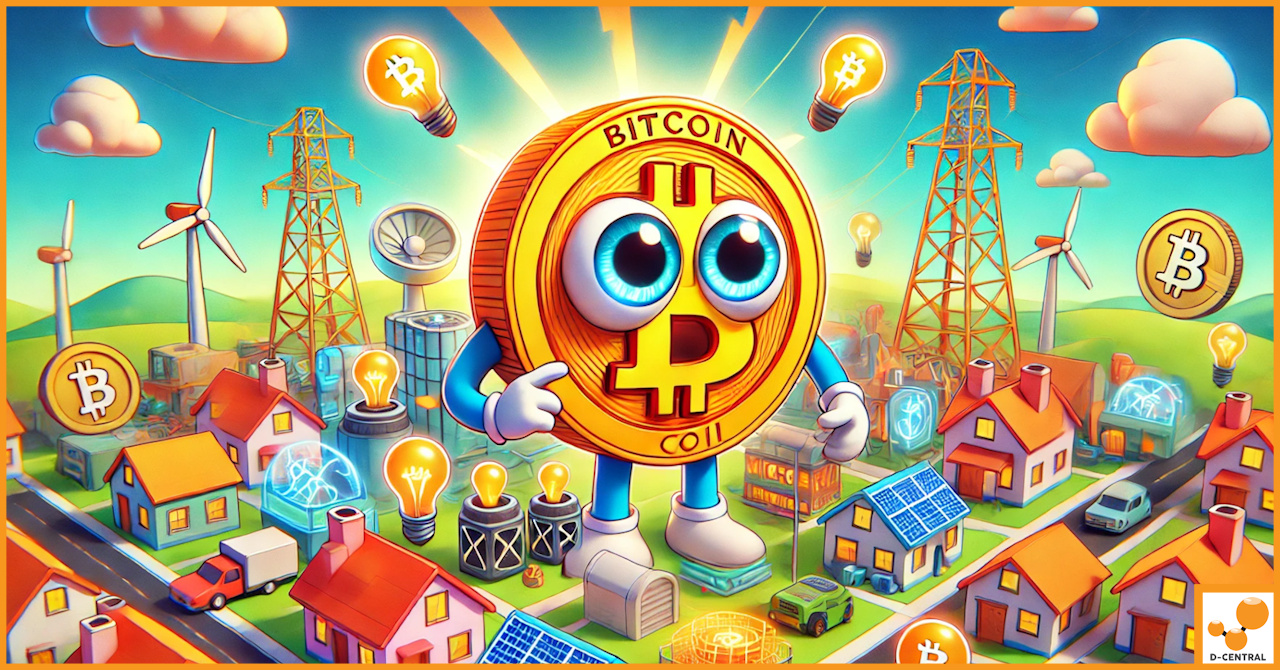
Home Bitcoin Mining and Local Microgrids: Fostering Energy Independence
Discover how D-Central’s innovative home cryptocurrency miners are transforming the landscape of energy consumption and grid resilience. Join the movement
4479 Desserte Nord Autoroute 440, Laval, QC H7P 6E2

In the rapidly evolving world of digital currencies, Bitcoin mining stands as a critical pillar, underpinning the very essence of the cryptocurrency realm. This intricate process, essential for the maintenance and growth of the blockchain network, involves miners performing complex computational tasks to validate and secure transactions on the Bitcoin blockchain. This not only ensures the integrity and continuity of the Bitcoin network but also results in the creation of new bitcoins, a process likened to digital gold mining.
Simultaneously, the world of energy trading, a less visible yet equally vital cog in the global economic machine, plays a crucial role in the distribution and management of energy resources. Energy trading markets are complex systems where energy commodities, including electricity, oil, and natural gas, are bought and sold. These markets are instrumental in balancing supply and demand, stabilizing prices, and ensuring the efficient distribution of energy across different regions.
The intersection of these two domains – Bitcoin mining and energy trading – presents a fascinating and increasingly relevant area of study. Bitcoin mining, known for its intensive energy consumption, intersects significantly with the dynamics of energy markets. This relationship raises critical questions and opportunities: How does the energy-intensive process of Bitcoin mining impact global energy markets? Conversely, how do the fluctuations and trends in energy trading affect the Bitcoin mining industry?
Bitcoin mining is the process by which new bitcoins are entered into circulation, but it is also a critical component of the maintenance and development of the blockchain ledger. It is performed using very sophisticated computers that solve extremely complex computational math problems.
Mining involves compiling recent transactions into blocks and trying to solve a computationally difficult puzzle. The first participant who solves the puzzle gets to place the next block on the blockchain and claim the rewards. These rewards, which incentivize mining, are both the transaction fees associated with the transactions compiled in the block as well as newly released bitcoin.
The process begins with miners collecting transactions from a network pool and assembling them into a block. To add this block to the blockchain, miners must find a specific numeric solution to a cryptographic algorithm known as the Proof of Work. This solution is unique to each block and requires miners to perform trillions of calculations per second to find it. Once a miner successfully solves the puzzle, the new block is added to the blockchain, and the miner is rewarded with bitcoins.
Miners play a crucial role in the Bitcoin ecosystem. They are responsible for securing the network and confirming Bitcoin transactions. Their efforts prevent double-spending, a unique challenge for digital currencies. By validating transactions and ensuring the integrity of the blockchain, miners help maintain the decentralized nature of the Bitcoin network, making it resistant to censorship and centralized control.
Bitcoin mining is a highly energy-intensive process. The computational power required to solve the Proof of Work puzzles and secure the network demands a significant amount of electricity. This energy consumption is necessary to maintain the network’s security and decentralization but has raised concerns about the environmental impact of Bitcoin mining.
The computational power in Bitcoin mining is measured in hashes per second. The total computational power used to mine and process transactions is known as the hash rate. Higher hash rates increase the network’s security but also imply greater energy consumption. As the Bitcoin network grows and the difficulty of mining increases, more powerful and energy-efficient mining hardware is developed to keep up with the demands.
The energy consumption of Bitcoin mining is influenced by several factors, including the efficiency of the mining hardware, the cost of electricity, and the overall network hash rate. Miners are incentivized to seek out the cheapest and most efficient energy sources to maximize profits. This search for efficiency has led to a growing interest in renewable energy sources and the development of mining operations in regions with lower energy costs. However, the overall energy consumption of the Bitcoin network remains a topic of environmental and economic discussion.
Energy trading refers to the buying, selling, and transferring of bulk energy from where it is produced to where it is needed. This market is crucial for the efficient distribution of energy resources, ensuring that the supply meets the demand across different regions. Energy trading can involve various commodities, including electricity, natural gas, and oil. The market operates on different scales, from day-ahead trading to real-time markets, and includes long-term contracts as well as short-term spot markets.
At its core, energy trading is about matching the supply of energy with its demand. Traders buy and sell energy to balance supply and demand, manage risk, and attempt to profit from price fluctuations. This trading is essential for the operation of a reliable and efficient energy system. It allows for the redistribution of energy from surplus areas to those with a deficit, thereby ensuring a stable energy supply.
The energy trading market includes a variety of participants, each playing a distinct role:
Energy prices are influenced by a complex interplay of factors:
The rise of renewable energy sources has significantly impacted energy trading:
Energy trading markets play a pivotal role in the global energy landscape, balancing supply and demand, and adapting to the evolving dynamics of energy production and consumption, including the increasing role of renewable energy sources.
The worlds of Bitcoin mining and energy trading are increasingly intertwined, presenting a unique intersection where the high energy demands of cryptocurrency mining meet the complex dynamics of global energy markets.
Bitcoin mining is renowned for its high energy consumption. This is primarily due to the intensive computational power required for the Proof of Work algorithm, which secures the blockchain and processes transactions.
The substantial energy requirements of Bitcoin mining have a significant impact on both local and global energy markets.
The relationship between Bitcoin mining and energy trading is complex and multifaceted. While mining operations significantly contribute to energy demand, they also offer unique opportunities for grid management and stabilization. As both industries continue to evolve, this intersection is likely to become an area of increased focus and innovation.
The relationship between Bitcoin mining and renewable energy is becoming increasingly significant as the industry evolves. This shift towards greener energy sources is driven by both environmental concerns and economic incentives.
The integration of renewable energy into Bitcoin mining not only addresses environmental concerns but also offers new opportunities for the energy sector. By acting as both a driver for renewable energy investments and a flexible tool for grid management, Bitcoin mining could play a pivotal role in the transition towards a more sustainable and efficient energy future.
The integration of advanced energy trading strategies in Bitcoin mining is reshaping the landscape of both industries. These innovative approaches not only enhance the efficiency of mining operations but also contribute to broader economic and environmental objectives.
The adoption of advanced energy trading strategies in Bitcoin mining holds significant promise for both economic efficiency and environmental sustainability. As these practices become more widespread, they have the potential to transform the energy consumption patterns of the mining industry and contribute positively to the global energy landscape.
The intersection of energy trading and Bitcoin mining is poised for significant evolution, driven by emerging trends, technological advancements, and a dynamic set of challenges and opportunities. Understanding these elements is crucial for navigating the future landscape of these intertwined sectors.
The future of energy trading and Bitcoin mining is marked by a landscape rich with both challenges and opportunities. Navigating this future will require adaptive strategies, technological innovation, and a commitment to sustainability. For stakeholders in both sectors, this represents a unique chance to redefine the boundaries of energy and finance, paving the way for a more integrated and sustainable future.
In this exploration of the dynamic interplay between Bitcoin mining and energy trading, we have delved into various facets of these two interconnected realms. From the energy-intensive nature of Bitcoin mining and its evolving relationship with the global energy markets to the innovative strategies being employed to make mining operations more sustainable and efficient, it’s clear that we are at a pivotal juncture in the history of both industries.
We have seen how Bitcoin mining, traditionally known for its high energy consumption, is increasingly turning towards renewable energy sources, driven both by environmental considerations and economic incentives. This shift not only addresses the sustainability concerns associated with mining but also presents new opportunities for growth and innovation in the renewable energy sector.
The role of advanced energy trading strategies in Bitcoin mining has also been highlighted, underscoring the potential for these practices to enhance the economic and environmental efficiency of mining operations. These strategies not only benefit miners by reducing costs and optimizing operations but also contribute to the stability and sustainability of the broader energy grid.
Looking to the future, the challenges and opportunities that lie ahead for both Bitcoin mining and energy trading are significant. The integration of these two sectors is poised to continue, driven by technological advancements, regulatory changes, and the ongoing global push towards renewable energy.
D-Central Technologies, as a leader in the Bitcoin mining industry, is at the forefront of these developments. With our expertise in energy-efficient mining solutions and our commitment to sustainability, we are uniquely positioned to contribute to and benefit from the evolving synergy between Bitcoin mining and energy trading.
We invite our readers to explore the range of services offered by D-Central Technologies. Whether you are new to Bitcoin mining or looking to optimize your existing operations, our team of experts is here to guide you through every step of the process. Join us in this exciting journey as we navigate the future of Bitcoin mining and energy trading, working together towards a more sustainable and efficient world.
DISCLAIMER: D-Central Technologies and its associated content, including this blog, do not serve as financial advisors or official investment advisors. The insights and opinions shared here or by any guests featured in our content are provided purely for informational and educational purposes. Such communications should not be interpreted as financial, investment, legal, tax, or any form of specific advice. We are committed to advancing the knowledge and understanding of Bitcoin and its potential impact on society. However, we urge our community to proceed with caution and informed judgment in all related endeavors.
Related Posts

Discover how D-Central’s innovative home cryptocurrency miners are transforming the landscape of energy consumption and grid resilience. Join the movement

Bitcoin, the pioneering cryptocurrency, has revolutionized the financial landscape with its decentralized nature, challenging traditional centralized banking systems. Unlike conventional

In the rapidly evolving world of cryptocurrency mining, Application-Specific Integrated Circuit (ASIC) technology has emerged as a cornerstone, revolutionizing the